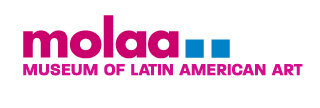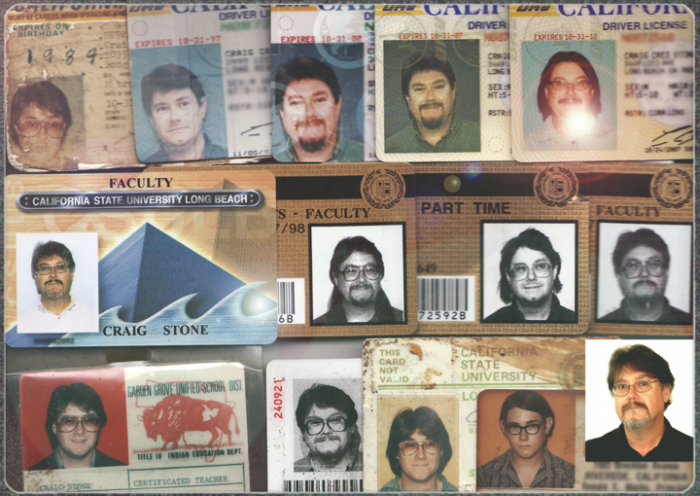WHO ARE YOU
JAn. 17 – MAR. 13, 2016
CRAIG STONE
Image Credit: Craig Cree Stone (US, b. 1955) Photo IDs of the Artist, 1973-2011. Courtesy of the Artist
What is an “identity”, and what advice can you give someone who is discovering their identity?
In the California I live in, identities can shift over a lifetime and also on a daily basis as one moves from one cultural setting to another. Gender identity is good example of how particular biological markers of gender are no longer as fixed and absolute as many once thought and with DNA testing and on-line genealogy people who understood themselves to be one thing are currently reconceptualizing their identities base on the availability of information that our ancestors could have never imagined.
I identify as a Southern Californian Artist or as a Long Beach Artist because I have lived in Southern California for most of my life and my artwork reflects my lived experience in this community. The California I know is comprised of many different communities each with a unique history of creative production and celebration that takes many forms and reinforces particular worldviews, histories, beliefs and cultural values. Living in Southern California I have had the opportunity to participate in and contribute to different creative communities including the mainstream museum gallery system as a studio artist.
In the Long Beach arts community, I am most known for my public artworks such as the permanent street art “shadows” stained on the sidewalks in Belmont Shore, the sculptures and the plaza on the first block of the Promenade (next to the Renaissance Hotel) and the artwork, as a hilltop park, in Signal Hill.
When has your identity been compromised, and what advice can you give someone whose identity is being challenged?
Be patient with your identity development. I suspect that your identity will change over time and that this will be a journey that takes a lifetime. If you are active in different communities you might find that you have several different identities that may or may not overlap with one another. As an artist, you should accept what you have experienced in life is an authentic lived experience that is reflective of our culture at this point in time and to make art about things that matter to you and pose questions that you are curious about and values that you want to reinforce. The art historian E. H. Gombrich wrote about how an artist might look at what other artists do and copy what they do to become an actual artist over time in the same way that a person will copy traits of an identity that one wishes to assert.
Gombrich suggested that in these early stages that these artists are pretentious, so pretending to be an artist should be understood as an early part of the process of becoming an artist. Initially, artists often conform to media stereotypes or exaggerated traits of identities to “perform identity” so challenges to your identity as an artist generally come early on when you are “in the process of becoming” and acting pretentious. If I recall correctly, Gombrich once wrote that any line drawn across the gradient of human activity is arbitrary.
Over time, one question that has resonated with me is: Who is drawing this line between identities and whose power and worldview is reinforced by making these distinctions between who is and who is not one of a particular group.
Identity Theft:
In terms of when my identity has been stolen, it was when my credit card was stolen and a person used my identity to steal my money.
Identity of the Artist:
When you are an artist or creative person, others often represent you and your creative work, some people who you have know for a long time and others who you barely know at all. These folks feel inclined to, or are charged with, reporting on, explaining, promoting, selling and representing the artist’s creative work. Generally, well-intentioned, they often do a good job but they often build you up to be more than you are or simply misrepresent the artist and artwork to make it sound better to the person or group that they are speaking to. In making you and your artwork fit their values and their view of art, your idea of your identity can be compromised.
There is also the idea that when it comes to Art that it does not matter what the artist intended. For some people, the only interpretation that matters is what the audience, collectors, scholars or critics think as this interpretation of the artwork by the members of the Art community shapes and influences the identity and value of the artist and their work. So as an artist, how your intentions are understood to the broader public and what your identity is, is negotiated and constructed by you and members of the community who reaffirm your identity.
Identity Compromised:
When my identity as an artist has been compromised, it has been when I have participated in an exhibition, production or film where my artwork has been misrepresented and promoted by the organizers as representing a community, worldview, philosophy or ideology that has little to nothing to do with these particular artworks. In these few instances, I have asked these folks to stop making these assertions and I have not worked with them again.
What actions and/or tools do you use to remind yourself about the value of your unique identity? How can someone be proud of who they are?
Personally, we participate in a variety of cultural activities on a regular basis and base our vacations on gathering with family and extended family when family histories and cultural values are shared.
Accepting who you are and gaining self-knowledge about who you are may be a good way to start. Staying away from people who denigrate you because of your identity is also a good idea. Being around others who support or share your values and interests in particular aspects of your identity could also be important to reaffirming pride in your identity. This can take place in a variety of situations such as taking a class or joining a community organization to engage with others who take pride in their identity. Today one can also find books, websites, and media produced by members of your communities that reaffirm cultural values seldom available on the major networks. The Southern California PBS station, FNX (First Nations Experience) is a good example of this type of media.
Self-knowledge is empowering especially if you are part of a community whose history is not taught about in our schools. Learning about our untaught histories, the resilience of our ancestors, our cultures, values and beliefs helps us to understand our unique histories, ways of understanding the world and the our contributions to it is very important to building self-knowledge. Taking time to talk to all of your elders and to listen to their stories and to learn from their lives is something to cultivate as they are a resource that may be gone before you have the opportunity to learn from them. Reading about and participating in events and activities where aspects of your identity are celebrated and examined can help to balance the lack of opportunities to learn things that inform who we are that are not taught in schools.
My mother’s great uncle, Peter Estrada, would tell us stories and then ask if we understood the meaning of each story. These were not stories that were on TV or stories that we learned in school. These stories were from his lived experience and while they were all different, they all had the same moral – be nice to all people, because, you never know how you are related to others.
You can follow Craig on:

